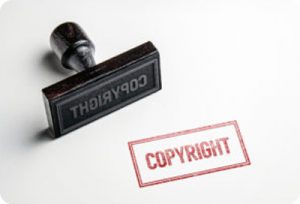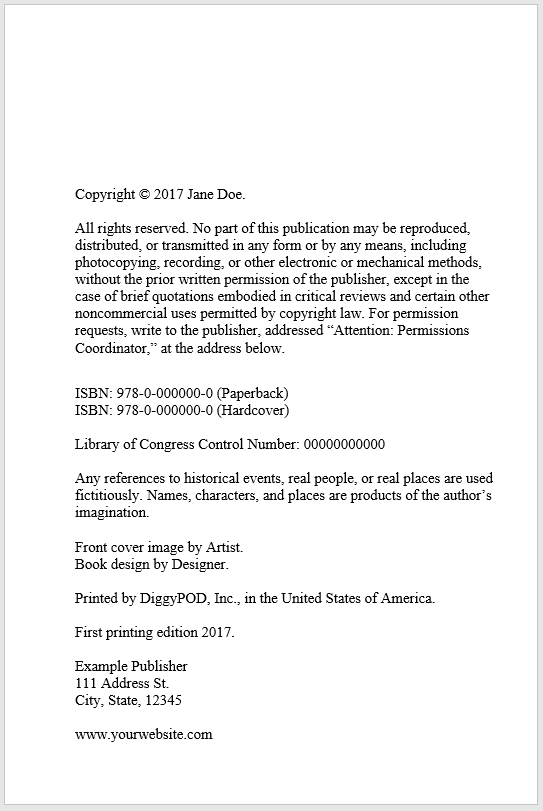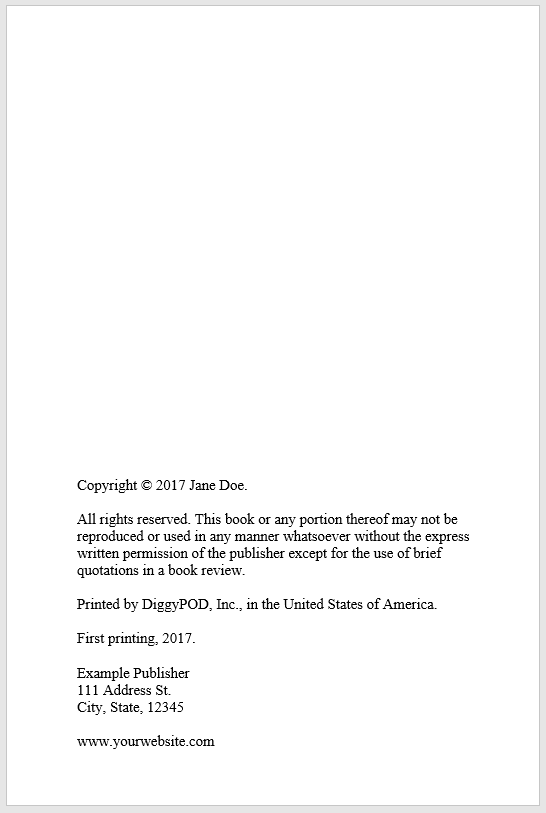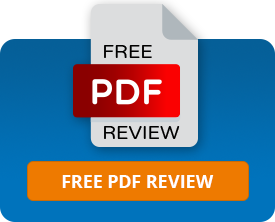Copyright
Copyright
Copyright
How to Create a Copyright Page
 As a part of the front matter, a book's copyright page is very important, especially if you want to protect your writing from plagiarism. The front matter also includes sections such as the epigraph, the dedication, the foreword, the prologue, etc. The copyright page is most commonly found on the back of the book's title page. The copyright page is standard in any book — where it's poetry, fiction, nonfiction, memoir, or comic. Self-published books are no different, so they should include a copyright page.
As a part of the front matter, a book's copyright page is very important, especially if you want to protect your writing from plagiarism. The front matter also includes sections such as the epigraph, the dedication, the foreword, the prologue, etc. The copyright page is most commonly found on the back of the book's title page. The copyright page is standard in any book — where it's poetry, fiction, nonfiction, memoir, or comic. Self-published books are no different, so they should include a copyright page.
According to the United States Library of Congress, copyright protects, "original works of authorship including literary, dramatic, musical, and artistic works, such as poetry, novels, movies, songs, computer software, and architecture."
As a first time self-publisher (or even an established one!), you're bound to have questions pop up along the way of your writing journey. Self-publishing puts a lot of work onto the author's shoulders, so DiggyPOD works hard to make everything as simple as possible in order to get your book printed faster. Copyright law is pretty intricate, so on this page we'll break down everything the aspiring self-published author needs to know in order to protect their work.
What Does a Book Copyright Page Include?
Copyright may seem intimidating, but what goes on a book's copyright page is pretty simple once broken down. We're going to walk you through, step-by-step, what should be included on your book's copyright page. The following is an example of a long copyright page, and this is what is typically found after the book's title page:

The long copyright page should include the following:
1. A copyright notice and year
The copyright symbol ("©") should go next to the copyright owner's name. It should look like, "© 2017 by Jane Doe," or can be spelled out "Copyright © 2017 Jane Doe." The copyright owner is the author of the book, not the publisher or the printer. If any company requires that they be the copyright holder, don't publish with them. It's your work, regardless of who is printing it.
If you use a pen name (also known as a pseudonym), you can put that on the copyright page instead of your real name. However, when registering your copyright with the U.S. Copyright Office, be sure to include both names on the form (pen name and legal name) since it is a legal document.
The copyright year is the year you receive your copyright. If the book is reprinted into new editions, the copyright will list all of the edition years, starting with the latest. For example, if you first published a book in 2012, but published more editions in 2014 and 2017, it would read as such: "Copyright © 2017, 2014, 2012."
Be sure that the copyright year is the year your book is published, not written. Your copyright will last for the duration of your lifetime plus an additional 70 years. After that, the work is considered public domain.
2. Rights reserved notice
The rights reserved notice states that the copyright holder (author) reserves all rights to reproduce the book or portions of the book. This phrase was created in the early 20th century at the Buenos Aires Copyright Convention, and it is technically no longer needed, as owning a copyright means that the author holds all the rights. It's still used in books, however, as a formality.
You can go as simple as stating, "All rights reserved," or you can expand upon it:
- All rights reserved, including the right to reproduce this book or portions thereof in any form whatsoever. For information, address the publisher.
- All rights reserved. This book or parts thereof may not be reproduced in any form, stored in any retrieval system, or transmitted in any form by any means—electronic, mechanical, photocopy, recording, or otherwise—without prior written permission of the publisher, except as provided by United States of America copyright law. For permission requests, write to the publisher, at "Attention: Permissions Coordinator," at the address below.
Any of these will do, it just comes down to your preference.
3. ISBN
An ISBN (International Standard Book Number) is necessary if you plan to sell your book. ISBN are always 13 digits long, and the numbers correspond with regional codes, particular publishers, editions, etc. The ISBN is merely an identifier for your book; it has no legal weight. If you don't plan on selling your book, then there's really no need for an ISBN. If you do plan on selling your book, however, you'll need one for most retailers. If your book comes in more than one format (say, paperback and hardcover) you'll need different ISBNs for each.
You can purchase an ISBN through Bowker. It's easy to buy an ISBN (or several, if you have several books) online and assign them to your books via your online account. Just as with the copyright, you should be the owner of the ISBN number, not your printer or publisher, so be sure to buy it from Bowker only.
4. Library of Congress Control Number
The Library of Congress Control Number (LCCN) is free to obtain (you can apply online) and shows that your book exists. It's necessary should you want to have it shelved in libraries, since libraries won't accept a book unless it has a LCCN.
If you don't want your book in a library (if you just want to sell it or give it to friends and family members as gifts), there's really no need to go through the process of registering your book with the Library of Congress.
5. Disclaimer
The disclaimer featured in the photo above is normally used in fiction books and is included to protect you from potential lawsuits if your characters or plot lines resemble real people or events. This disclaimer acknowledges that some characters may resemble real people, yet it affirms that this is a work of your imagination.
Disclaimers may also be used in nonfiction. If you're writing a memoir, you may choose to include a disclaimer that simply states that the events in the book are your memories from your perspective. You may also include a notice that certain names have been changed to protect the identities of those involved. This is often done when a work contains sensitive material.
For example, in Marina Keegan's posthumous The Opposite of Loneliness, which is a work of both fiction and nonfiction, the copyright page includes two disclaimers:
- Portions of this book are works of fiction. Any references to historical events, real people, or real places are used fictitiously. Other names, characters, places and events are products of the author's imagination, and any resemblances to actual events or places or persons, living or dead, is entirely coincidental.
- Portions of this book are works of nonfiction. Certain names and identifying characteristics have been changed.
6. Permissions notice
If you borrow excerpts from any other work (another book, artwork, articles, etc.) you need to give credit on the copyright page.
For example, in The Girls of the Atomic City: The Untold Story of The Women Who Helped Win World War II, Denise Kiernan includes this permissions notice of photographs used:
- All photos are by James Edward Westcott, courtesy of the National Archives, with the exception of: insert page 1, top left, courtesy of Celia Klemski; insert page 1, top right, courtesy of Colleen Black…
7. Credits to editors, photographers, and illustrators
This is optional and could instead be placed in the Acknowledgements section. If you choose to include these credits in your copyright page, you can still expand on them in the acknowledgements section. Most books will at least include illustration and design credits on the copyright page.
8. Country of printer/printing edition
This is where the book was printed and what edition it is (first or second or third, etc.). If you're using a POD printer, like DiggyPOD, you can include their information here, as well. This portion of the copyright page is included for customs purposes.
9. Publisher information
Publisher information (such as the name and address) should be included in the copyright page. If you're self-publishing, this would be your information. Some self-publishers choose to create their own publishing company instead of simply going by their name. If you'd like to go by your name, however, that's fine, too! You're the publisher. You get to decide how this section looks.
10. Author website
Since you're self-publishing, your personal website should be included on this page. It's a simple way to promote your personal site and get more eyes on your other work.
The following is an example of a short copyright page:

As you can see, included in the short copyright page is the copyright notice and year, rights reserved, country of printer, publisher information, and publisher website. Some copyright pages may even be as simple as only stating the copyright owner and year. That's enough to prove that the book is insured and protected under the law. In traditional publishing, the publishing house will decide how long this section is and what it includes, but when you self-publish, you will be writing the copyright page. Including all of the aforementioned details is thorough and professional, but if you choose to simply list the copyright holder and date, that will work just as well.
Why Should You Create a Copyright Page for Your Book?
Copyrighting your creative work ensures that no one will reproduce or recreate it under their name. Copyrights protect intelligent property so that if anyone attempts to steal or plagiarize a book, they'll face legal charges. It may seem unimportant if you're self-publishing, but you don't want to take a risk with the book you've worked so hard to write and publish.
Should Self-Publishers Register Their Book with the Federal Copyright Office?
The short answer is yes. Technically, as soon as you write something, it's protected under copyright law. This seems easy and a little too good to be true, right? Well, that's because you should still register the copyright with the U.S. Copyright Office. Registering your book protects you should you find yourself in the unfortunate circumstance of someone trying to steal your work. Having this copyright proves that you are the original author of the work.
How to Copyright Self-Published Work
You can register your work with the United States Copyright Office (a division of the Library of Congress) pretty easily.
To register a work with the U.S. Copyright Office, you must submit a completed application form and a copy (or copies) of the work you're registering. This process can take anywhere from 8 to 13 months. First-time registration fees range from $35 to $85 and lasts for 70 years after the death of the author. For more information on how to register your book, visit the U.S. Copyright Office's FAQ page.
It's important to register your copyright when you publish your book, not as soon as it's written (since it will likely go through revisions and edits).
Writing Your Copyright Page
Use the above examples as templates when creating a self-published copyright page in your book. Simply fill in your information — ISBN, copyright year, publisher, printer, website, etc. If you choose to print with DiggyPOD (and we hope you do!), you'll just need to add this page into your word document before you convert your files into print-ready PDFs. This will just be another page in your book!
To create the copyright symbol (©) on your computer, follow these steps:
If you're writing your book on a Mac, hold down the 'Option' (or 'Alt') button + 'G'
Or, if you're writing your book on a PC, hold down 'ALT' + '0169'
Copyrighting your book doesn't need to be complicated. Like anything in self-publishing, it's completely doable and easy as long as you have the right information and a good printer behind you. DiggyPOD aims to help the self-publisher every step of the way, assuring their book is the very best it can be and that it's protected. We highly recommend you officially register your work with the U.S. Copyright Office. Do yourself and your work a favor and copyright your self-published book. It's a quick and efficient way to safeguard your book and make it even more professional.
If you have any questions about formatting a copyright page for a book, please give us a call at (877) 944-7844.
Next Chapter > Book Selling
We Are Proud of our Five Star Rating!
"The product was delivered exactly as promised in a timely manner. The customer service was also quite helpful. Overall I was quite satisfied and the person who received the books as a gift was delighted."
“I would like to thank you for all your help in getting my book published. I found the process to be very user friendly especially for a beginner like me. The books arrived and I was pleased on how professional they looked."






